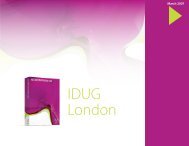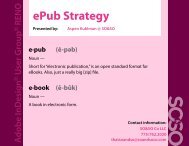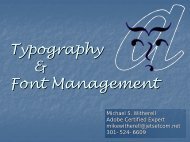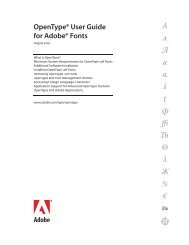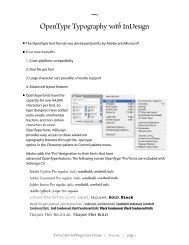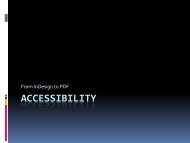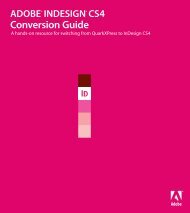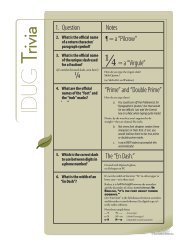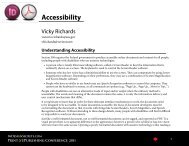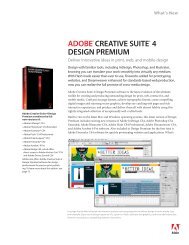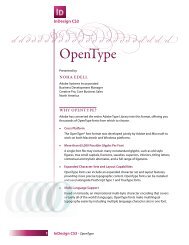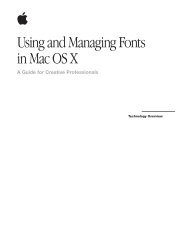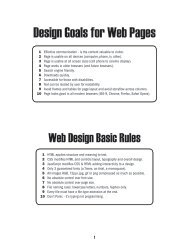Quark to InDesignCS3 Conversion Guide - InDesign User Group
Quark to InDesignCS3 Conversion Guide - InDesign User Group
Quark to InDesignCS3 Conversion Guide - InDesign User Group
You also want an ePaper? Increase the reach of your titles
YUMPU automatically turns print PDFs into web optimized ePapers that Google loves.
showing and hiding note markers<br />
and for navigating through the notes<br />
in a document, and in the S<strong>to</strong>ry Edi<strong>to</strong>r<br />
(Edit > Edit In S<strong>to</strong>ry Edi<strong>to</strong>r).<br />
The Eyedropper <strong>to</strong>ol lets you copy<br />
character, paragraph, fill, stroke,<br />
and transparency attributes from<br />
any object, including an imported<br />
graphic. Double-clicking the<br />
Eyedropper <strong>to</strong>ol displays the<br />
Eyedropper Options dialog box,<br />
which lets you specify the attributes<br />
the Eyedropper <strong>to</strong>ol copies.<br />
The Gradient Swatch <strong>to</strong>ol lets you<br />
specify the start point, end point,<br />
and angle of a gradient; the<br />
Gradient Feather <strong>to</strong>ol lets you<br />
create a gradient that changes<br />
from opaque <strong>to</strong> transparent.<br />
The Hand <strong>to</strong>ol lets you adjust the<br />
visible portion of the page within<br />
the document window.<br />
The But<strong>to</strong>n <strong>to</strong>ol lets you create but<strong>to</strong>ns<br />
that will initiate actions, such<br />
as navigating <strong>to</strong> a different page, or<br />
playing an audio or video clip, when<br />
you export your <strong>InDesign</strong> layout as<br />
an Adobe PDF file. After you create<br />
a but<strong>to</strong>n, use the controls in the<br />
But<strong>to</strong>n Options dialog box (Object ><br />
Interactive > But<strong>to</strong>n Options) <strong>to</strong><br />
specify the but<strong>to</strong>n’s behavior. But<strong>to</strong>ns<br />
become active only in an exported<br />
PDF document.<br />
the Quick Apply window provides easy access <strong>to</strong><br />
paragraph, character, and object styles, and many other<br />
<strong>InDesign</strong> features.<br />
The Fill box lets you apply color<br />
(solid, tint, or gradient) <strong>to</strong> objects;<br />
the Stroke box lets you apply a<br />
stroke <strong>to</strong> objects. The Default Fill<br />
And Stroke icon (lower left) lets you<br />
return the Fill and Stroke boxes <strong>to</strong><br />
their default settings (no fill, black<br />
stroke). The Swap Fill And Stroke<br />
icon (upper right) switches the<br />
stroke and fill colors. The attributes<br />
associated with the Fill and Stroke<br />
icons when nothing is selected are<br />
applied <strong>to</strong> new objects.<br />
what’s the easiest way <strong>to</strong> access<br />
commonly used <strong>InDesign</strong> features?<br />
<strong>InDesign</strong> has context-sensitive<br />
menus that display commands<br />
related <strong>to</strong> the active <strong>to</strong>ol or selection,<br />
providing quick access <strong>to</strong> commonly<br />
used commands. To display a<br />
context-sensitive menu, right-click<br />
a selected object. For Mac OS users<br />
who don’t have a two-but<strong>to</strong>n mouse,<br />
press the Control key as you click the<br />
mouse. A context-sensitive menu is<br />
also displayed if you right-click when<br />
nothing is selected.<br />
When the Type <strong>to</strong>ol is selected and<br />
text is highlighted, the contextsensitive<br />
menu displays many of<br />
the commands in the Type menu,<br />
including Cut, Copy, and Paste;<br />
Font and Size; and Text Frame<br />
Options. When the Selection <strong>to</strong>ol is<br />
selected, the context-sensitive menu<br />
displays many of the commands<br />
in the Object menu, including<br />
Transform, Arrange, Select,<br />
Effects, and Display Performance.<br />
The Quick Apply feature<br />
(Command+Return in Mac OS<br />
or Ctrl+Enter in Windows) also<br />
provides quick access <strong>to</strong> styles,<br />
menu commands, text variables,<br />
and scripts.<br />
Quick Apply icon<br />
Context-sensitive menus<br />
display commands<br />
related <strong>to</strong> the active <strong>to</strong>ol<br />
or selection. this<br />
example shows the<br />
commands available<br />
when the text insertion<br />
point is blinking.<br />
Interface Differences 17




